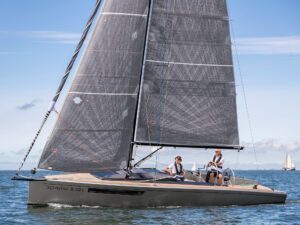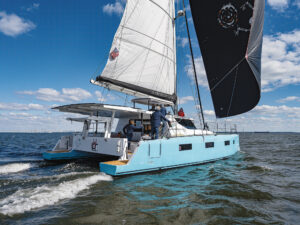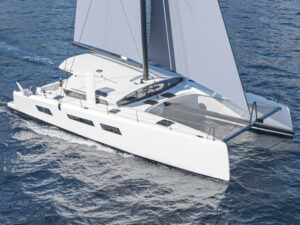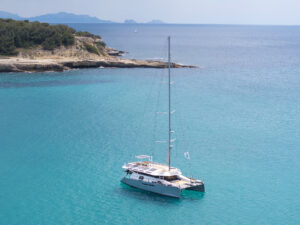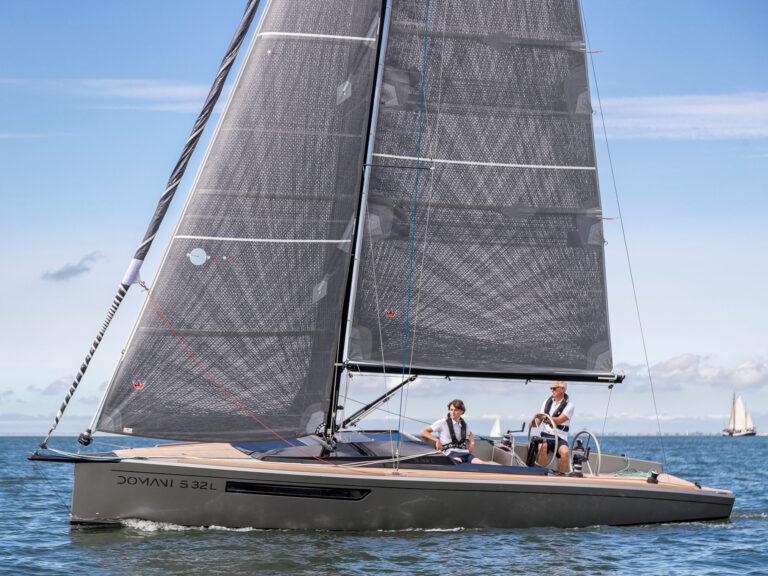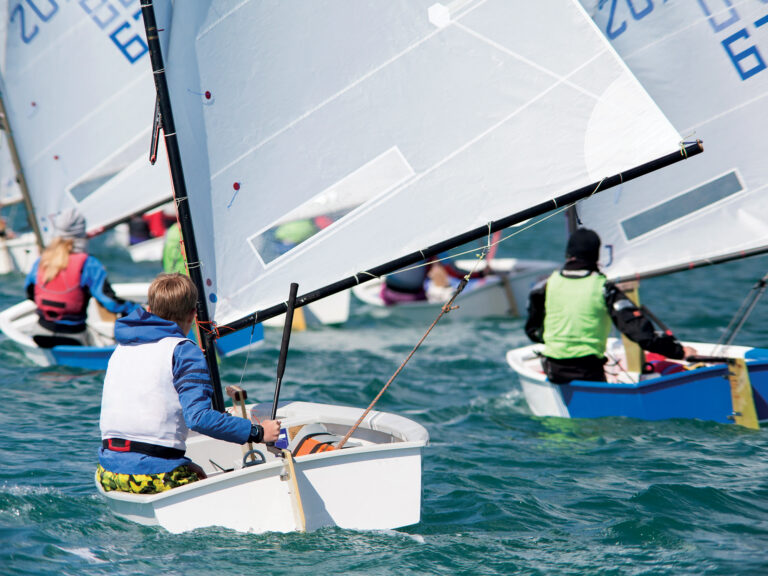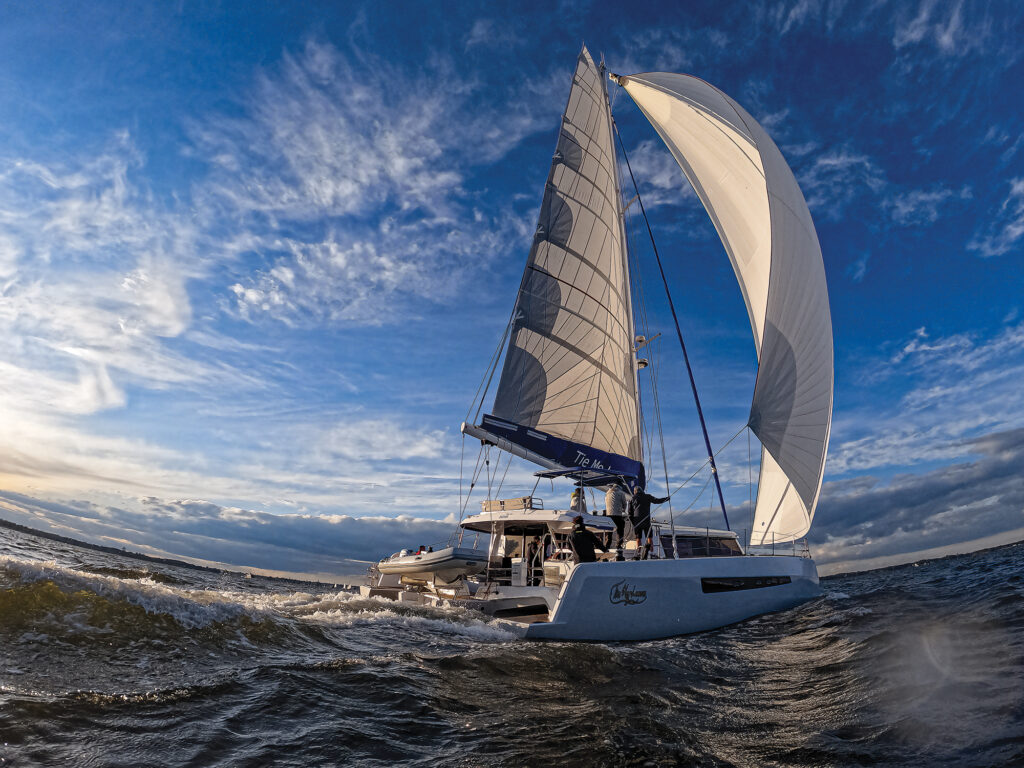
Way back when, several decades ago, I scored my first ride aboard a cruising trimaran: a sweet, cold-molded beauty called Juniper. Today, naval architect Chris White is well-known for his long line of Atlantic catamarans, all of which are laid out with his signature feature: a forward cockpit for the helm and sail controls (something that several notable designers and brands, including Gunboat, have copied). White has always been a multihull man, and it’s interesting that for his own first boat, he chose a tri, on which he completed several offshore voyages from New England to the Bahamas.
Personally, I loved Juniper, an elegant creation that sailed like a witch. And it had a beautiful, handcrafted wood interior. But to me, the yacht’s basic configuration also seemed like a major drawback, something that would prohibit trimarans from becoming mainstream cruisers.
The accommodations were confined to its central hull, with a relatively narrow beam that limited options. As time went by—and the multihull world became dominated by cats—I felt quite smug about my early observation: If you want a true, cruising multihull, you’ve got to go with a cat. Trimarans weren’t on the radar.
In recent times, thanks to my role as a judge for Cruising World’s annual Boat of the Year contest, I’ve been persuaded to rework my original stance. In 2024, our panel was collectively blown away by a Danish import, the Dragonfly 40, which easily won the prize for Best Performance Trimaran. As sweet as that Dragonfly was, with accommodations that were well-executed, they remained confined in the same way as those on Juniper.
For 2025, though, we stepped aboard a trimaran that was a much different beast. The Neel 52 greatly expanded the interior options and layout by spreading them out over much of the boat’s nearly 30-foot beam. It was a groundbreaking boat, and we recognized it as such, awarding it top honors in the Best Full-Size Multihulls Over 50 Feet category versus a pair of big, stellar catamarans (the Windelo 54 Yachting and the Xquisite 60 Solar Sail). At least for 2025, in our humble opinions, three hulls were better than two.
For the 52’s lines, the company commissioned the Lombard Design Office, which is still knocking out good boats following the death of its founding naval architect, Marc Lombard. Here’s their summation of the design brief: “To create multipurpose arrangements with up to six double cabins with direct access from the central main cabin. Aesthetic lines with moderate freeboard. A strong and stiff platform. Less hull drag, more dynamic trim at high speeds. Improved hull shapes for better efficiency and safety in waves, an important requirement for an ocean-crossing trimaran.”
Generally speaking, I’ve always considered the lines of a trimaran—that relatively prominent middle hull sandwiched by a pair of graceful amas, like a set of wings—to be more aesthetically pleasing than those of many cruising cats, which can sometimes appear boxy. And to my eye, the 52 is a good-looking vessel with a host of features. The raised helm station to starboard, minimalist coachroof with expansive windows, upper-deck lounge with settees and a sunbed, dedicated sprit forward for off-wind sails and ground tackle, and pair of swim platforms aft all blend together to make a pleasing whole. There are robust stainless-steel grab rails everywhere, and synthetic teak accentuates the wide side decks.
The boat’s signature feature, however, lies within the interior framework, in what the company had dubbed the “cockloon.” It’s an open floor plan that combines the beam-width cockpit (an outdoor galley is an option) with the central saloon. The bridge deck also houses the owner’s stateroom, a professional-grade galley, and a nicely rendered navigation station fitted out with a suite of B&G instrumentation. The delightful views from the panoramic array of windows is all-encompassing.
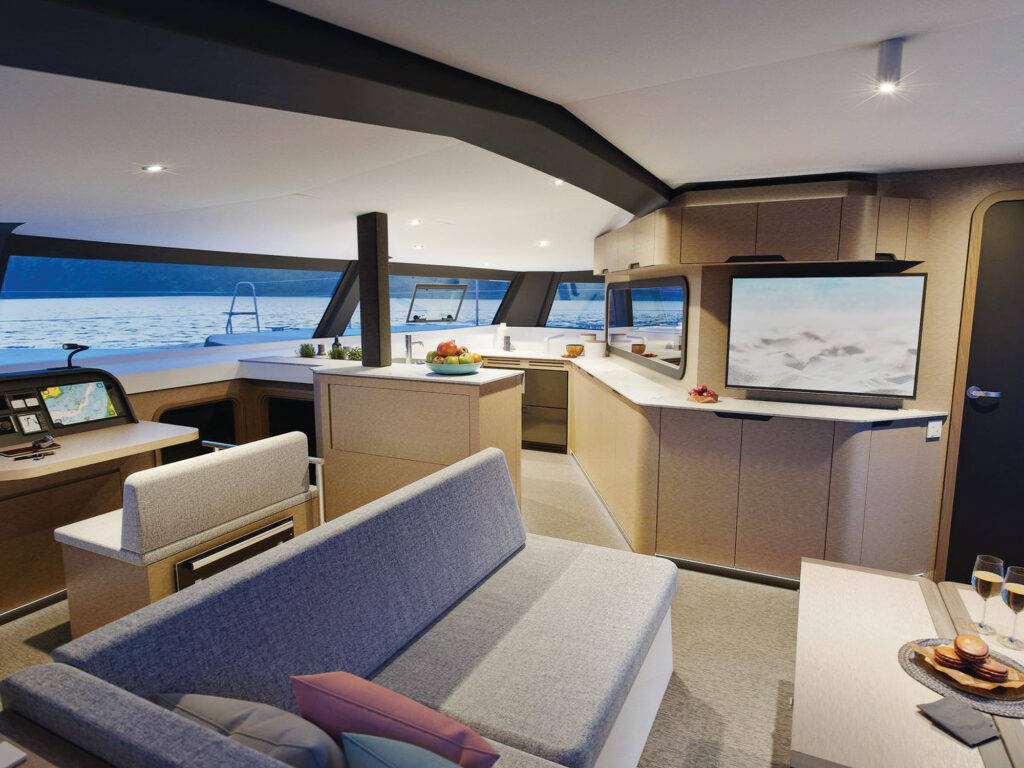
Down below, there are several layouts with multiple double cabins, including a V-berth forward in the bow (on our test boat, one of those bedrooms was swapped for a generous technical room with a workbench, workspace and tool stowage).
Fellow Boat of the Year judge Mark Pillsbury was quite enamored of the cockloon arrangement: “Owners don’t just get their own stateroom aboard the Neel 52 trimaran. They get a two-story suite with a head, shower and private office located aft in the starboard ama. There’s a stunning view from the walk-around double berth, with picture windows affixed with venetian blinds, which is located on the bridge deck. The living space on this boat is tremendous.”
Indeed, this is a voluminous yacht, and the relatively deep draft (for a multihull) of almost 6 feet in its fixed keel provides lots of space for the creative Neel team. The US importer for the boat is Miami-based broker Alex Sastre, who played a major role in developing the quite incredible engine room nestled deep in the boat’s innards. It houses a 48-volt system that’s charged with an integral set of twin alternators and a solar array (our test boat was also equipped with a hefty Cummins Onan genset and a lithium-ion battery bank, both of which are optional). All of it is clearly labeled and totally accessible, as are all the hoses and plumbing manifolds. There is also quick and ready access to the steering quadrant.
All of this also caught Pillsbury’s attention: “I could have spent the better part of a day going through the Neel’s engine room. There was even a bank of chargers for all your onboard power-tool batteries.”
Construction is solid and employs vinylester resin with an infused foam core. The handsome furniture and joiner work in the interior is solid oak. The standard double-spreader rig is aluminum, but a carbon mast, including the one on our test ride, is optional. Auxiliary power is provided by a 150 hp Volvo Penta diesel with a saildrive configuration, and docking is assisted with a Max Power bow thruster.
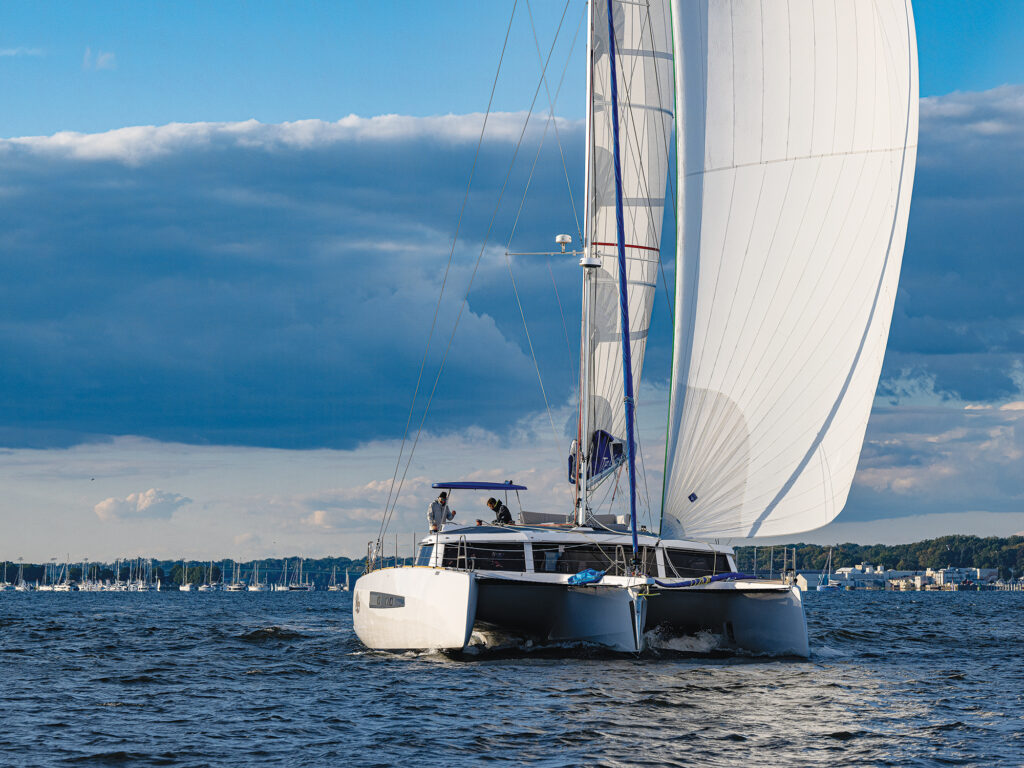
At the end of the day, though, every sailboat will ultimately be judged by the simplest of criteria: how well it performs under sail. In our sea trials this past fall on Chesapeake Bay in a 14- to 16-knot northwesterly breeze, the 52 just smoked it. It’s hard to describe the sensation of steering the boat from the raised helm station. It’s something akin to taking a tennis court for a spin. It’s otherworldly.
The powerful, square-topped full-battened mainsail provided plenty of punch (a company rep said that it does not require reefing in less than 25 knots of breeze). The test boat had a full set of excellent Incidence sails from the popular French sail loft, including a jib, genoa, code zero and gennaker, all of which are controlled with a full suite of Harken winches and hardware.
The Neel reps said that the 52 will easily average better than 200 nautical miles on passage, and clearly they were not exaggerating. Jibing downwind with the big asymmetric kite, the boat easily topped 9 knots. Closehauled under genoa, the boat averaged 8.5 knots to windward with a maximum speed of 9.2 knots. Steering from that elevated wheel was a delight, with best-in-show 360-degree visibility at all times, something that can’t be said on most catamarans. Our judging group was unanimous: It was easily one of the contest’s best sea trials.
Back in the day, after sailing Juniper, it was difficult for me to envision a path forward for cruising tris to gain wide acceptance. And, truth be told, it’s still a steep, uphill road. But the Neel 52 makes the case that trimarans are not only viable, but they offer real advantages as well. If you want to start a revolution, that’s a good place to begin.
Take the Next Step
PRICE: $1.65 million (as tested)
CONTACT: pyachtsales.com
A Legacy Realized
There’s no question that the Neel brand of trimarans would not exist if not for the vision and drive of the company’s namesake and founder, Eric Bruneel. A talented shorthanded offshore racing sailor, his career took a winding path. For many years, he was the director of Fountaine-Pajot catamarans, one of France’s oldest and most popular builders. As a racer, however, for his own boats, he preferred the speed and stability of a trimaran, and he eventually launched his own firm with the goal of introducing cruising tris to the masses. He has since moved on, but his original concept appears to be in safe hands.
Full Speed Ahead
The Neel 52, the builder’s new flagship, replaces a 51-footer in the lineup, which also currently offers a 43- and a 47-footer (a 37 and a 44 have been discontinued). Among the 10 hulls of the 52 delivered thus far, all have had slightly different layouts, a testament to the company’s willingness to adapt to owners’ requirements. Neel produces about a dozen boats a year, with the goal of ramping up to 24 yachts annually.
CW editor-at-large Herb McCormick was a 2025 Boat of the Year judge.

